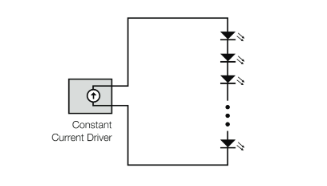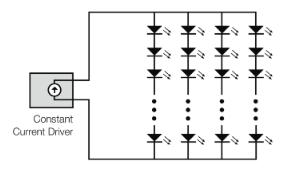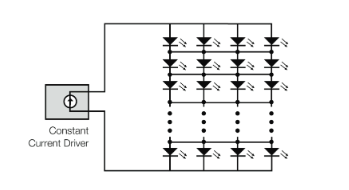Due to LED energy savings, long life, durability and flexible design, LEDs are rapidly replacing incandescent and fluorescent lights in indoor and outdoor lighting. But choosing the right LED is only part of the design equation. To achieve total efficiency, durability and longevity in your solid-state lighting design, you need to choose the right power source to match your application requirements to the LEDs you use. This article will provide you with some useful suggestions for some of the things you need to consider when choosing a power supply.
Related background introductionOnce the power supply voltage of the LED is equal to or greater than the forward voltage drop of the diode (typically in the 2-3V region), the LED begins to produce light. The current required for full brightness varies from device to device, but is typically 350 mA for a 1 W LED (usually the smallest size in lighting applications). Unlike incandescent lamps, LEDs are non-linear devices. This means that once the supply voltage exceeds the forward voltage of the diode, the passing current increases exponentially with the supply voltage. Without some form of current regulation, LED chips will become expensive, monostable flash bulbs.
To prevent this, the power supply must provide the proper voltage at the right current. The easiest way is to select a power supply with an output voltage greater than the forward voltage of the selected LED and use a current limiting resistor to limit the current to the maximum specified by the LED manufacturer. A disadvantage of this approach is that one of the main advantages of LED illumination is that the high efficiency is affected by the power dissipated by the current limiting device.
Lights and fluorescent lights. But choosing the right LED is only part of the design equation. To achieve total efficiency, durability and longevity in your solid-state lighting design, you need to choose the right power source to match your application requirements to the LEDs you use. This article will provide you with some useful suggestions for some of the things you need to consider when choosing a power supply.
Select powerThe type of power source selected for the lighting application will be based on several factors. First, consider the environment in which the application runs. Is the application indoors or outdoors? Does the power supply need to be waterproof or require a special IP rating? Can the power supply use conduction cooling or use only convection cooling?
Next, define the overall power requirements. A single luminaire may only require a small power supply, but a complex system may require hundreds of watts of power. Also, do you need other features? For example, does the power supply need to operate in a simple constant voltage mode or constant current mode, and does the application require dimming?
Regulations and regulations are importantWell, now is the time to consider the regulations. Does the entire system need to operate within a certain harmonic current range? Does it need to meet the safety standards for lighting, or is ITE power sufficient? And in this age of energy sensitivity, how can power supply effectively meet local or regional standards? Equally important, in some local government agencies, discounts or other subsidies are offered to products that meet specific efficiency and power factor correction levels. Are products sold in these locations? Again, it's important to know if your design criteria meet the requirements, including any requirements for power consumption when turning off the power. safety standard
There are various standards for lighting systems. Internationally, Part 1 of IEC 61347 covers the general safety requirements for luminaire control devices, and Section 13 (2) of Part 2 applies to LED module power supplies. The United States has UL8750, and Europe has EN61347, which are all named in the IEC format.
Tandem configuration
figure 2
LED series connection
In a series configuration, the individual LEDs are arranged in series. The advantage of this is that the same current passes through each of them, resulting in the same brightness of the emitted light. Another advantage is that if one LED fails during a short circuit, the other LEDs remain unaffected and remain lit. The disadvantage is that if an LED fails in an open circuit, the current will be interrupted and all other LEDs will be extinguished. Another disadvantage is that if many LEDs are needed to produce the required amount of light, the sum of the forward voltages may require a power supply that uses a relatively high output voltage.
Parallel configuration

image 3
LED parallel connectionWhen connected in parallel, the LEDs can still be arranged in series in two or more LED strings. The advantage is that for the same number of LEDs, ie the same brightness, the power supply can have a lower output voltage because the number of LEDs in each string can be reduced. Another advantage is that if one LED in one string becomes an open circuit, the other strings are unaffected and the luminaire can still illuminate but the brightness is reduced. The disadvantage is that because there is a slightly different forward voltage in each string, the current in each string cannot be precisely controlled by a single power supply, so each string may require a current balancing device, which reduces overall efficiency.

Figure 4
LEDs connected in a matrix configurationIn a matrix configuration, the LEDs can be similarly configured in a parallel configuration, but each LED between the string and the string is connected. The biggest advantage of this configuration is that if a single LED becomes an open circuit, there is still a path for current to flow through all of the other LEDs in the string, so the light output is hardly reduced. The main disadvantage is that it is more difficult to control the current in each string because the current balancing device cannot be used. This means that the LEDs used must have a closely matched forward voltage, which can add cost.
Surface Mounting Sensor
NTC temperature surface mount sensors are non intrusive type sensors consisting of a probe section designed for mounting to flat or curved surfaces.
Cables can be supplied with insulation or jacket in PVC, Teflon or Silicon. Some cables are also available with a stainless steel over-braid or stainless steel armor for additional protection.
With the properties of easy installation, surface temperature measurement, surface mount type NTC temperature sensor has been used to power supply, radiator, electric motor and generator. Temperature range is from -30°C to 105°C.
Surface Mounting Sensor,Surface Mount Sensor,Sensor Radiator,Surface Mount Ntc Sensor
Feyvan Electronics Technology Co., Ltd. , https://www.fv-cable-assembly.com